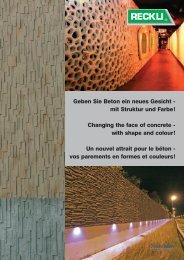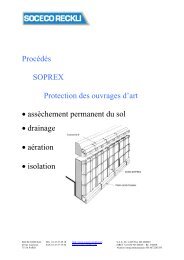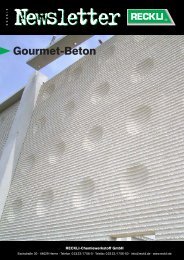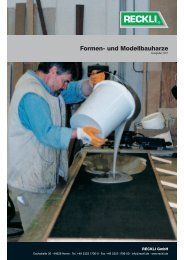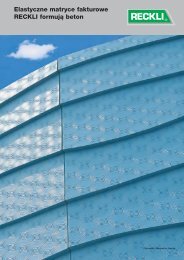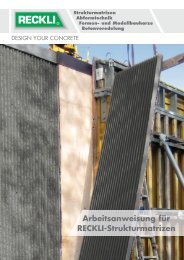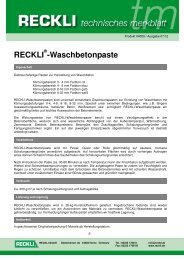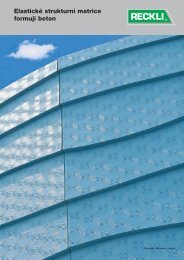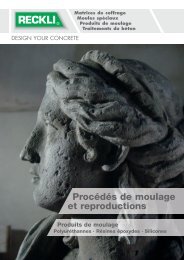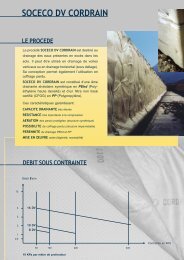Matrices individuales - US Formliners for Concrete
Matrices individuales - US Formliners for Concrete
Matrices individuales - US Formliners for Concrete
Create successful ePaper yourself
Turn your PDF publications into a flip-book with our unique Google optimized e-Paper software.
RECKLI <strong>Formliners</strong><br />
Description<br />
RECKLI <strong>Formliners</strong> are made from an<br />
elastic material <strong>for</strong> the patterning and texturing<br />
of all finished and ‘as struck’ concrete<br />
surfaces. The RECKLI <strong>for</strong>mliner<br />
system has a proven track record of over<br />
40 years application throughout the<br />
world.<br />
<strong>Concrete</strong> is still one of the most durable,<br />
economic and cost effective building<br />
materials available today. It presents all<br />
the advantages <strong>for</strong> creating safe, individual,<br />
aesthetic and variable construction.<br />
When in its liquid <strong>for</strong>m it allows almost<br />
unlimited possibilities of <strong>for</strong>ming and<br />
moulding to its final hardened shape.<br />
Architectural design is only restricted by<br />
the type of <strong>for</strong>mwork or mould employed.<br />
With RECKLI <strong>for</strong>mliners, these boundaries<br />
can be crossed easily and in an<br />
aesthetically exquisite manner and the<br />
possibilities are almost limitless. Further -<br />
more, the elastic <strong>for</strong>mliners not only aid<br />
the planner and operator in achieving the<br />
architectonic objective, a texture also<br />
runs through the varied interaction of light<br />
and shadow leading to an effective revival<br />
of facades and concrete surfaces.<br />
The RECKLI elastic <strong>for</strong>mliner system<br />
offers ideal possibilities to meet the highest<br />
quality requirements <strong>for</strong> finished and<br />
‘as struck’ concrete surfaces.<br />
Material<br />
Our <strong>for</strong>mliners are made from rubber-like<br />
polyurethane elastomers. Their high flexibility,<br />
elasticity and durability allow multiple<br />
damage free stripping and release to<br />
the concrete and give an exact reproduction<br />
of any patterned or textured surface.<br />
Application<br />
RECKLI <strong>Formliners</strong> are used in insitu and<br />
pre-cast concrete construction. In both<br />
applications the <strong>for</strong>mliners require suitable<br />
and sound foundation to be placed<br />
upon. Plywood should be of minimum<br />
quality ‘Douglas fir fair faced one side’. In<br />
pre-cast applications you may place the<br />
<strong>for</strong>mliners loose into horizontal moulds,<br />
<strong>for</strong>mwork or tilting tables or you can glue<br />
them. For vertical applications (in-situ<br />
concrete, battery-shutters) we strongly<br />
advise that you glue them to the shutter.<br />
For gluing use RECKLI Formliner<br />
Adhesive with suitable RECKLI primers if<br />
and when advised by RECKLI.<br />
The type, and quality of concrete do not<br />
limit in any way the use and application of<br />
RECKLI <strong>Formliners</strong>. It is immaterial<br />
whether the concrete is standard concrete<br />
or one using heavy or lightweight<br />
458<br />
aggregates, white cement, and coloured<br />
concrete or concrete with pigments.<br />
RECKLI <strong>Formliners</strong> can also be used with<br />
self-compacting concrete, fibre rein<strong>for</strong>ced<br />
concretes such as glass fibres,<br />
polypropylene, textiles, steel etc. It has<br />
been used successfully <strong>for</strong> many years in<br />
the GRC Industry.<br />
Reusability<br />
We supply the <strong>for</strong>mliners in various<br />
degrees of reusability. We have three<br />
classifications that we label with a series<br />
and a letter. The following classifications<br />
have the following meanings:<br />
C Series = 100 uses<br />
A Series = 150 uses<br />
E Series = 110 uses<br />
We can only guarantee the stated figures<br />
concerning the amount of uses provided<br />
that the auxiliary materials such as separating<br />
agents, adhesives and repair spatulas<br />
that are specially tailored to the plastic<br />
of the <strong>for</strong>mliners are also used.<br />
Due to manufacturing-related and structural<br />
reasons, not all designs can be supplied<br />
in all 3 series. There are also limits<br />
with regard to the dimensions. In<strong>for</strong> -<br />
mation concerning which structure can<br />
be manufactured in which series as well<br />
as the maximum dimension are noted<br />
underneath the structure images.<br />
Based upon the varying surface conditions<br />
of the <strong>for</strong>mliners, it may be the case<br />
that colour differences may occur in the<br />
visible concrete surface in the event that<br />
varying series are combined with one<br />
another.<br />
<strong>Formliners</strong> with prefix code 2/.. can be<br />
frequently manufactured in all 3 reusability<br />
classes. The <strong>for</strong>mliners with prefix<br />
code 1/.. are only regularly supplied in A<br />
and E series.<br />
<strong>Formliners</strong> <strong>for</strong> Single Use<br />
We also have available RECKLI-One-<br />
Timer <strong>for</strong>mliners. Please ask <strong>for</strong> our separate<br />
catalogue.<br />
Pattern design<br />
There is no intended repeatability (with<br />
the exception of any of the rib type patterns)<br />
in the <strong>for</strong>mliner patterns within the<br />
maximum mould size as compared to<br />
wallpapers. A number of patterns are<br />
designed in a way that they can be placed<br />
together side by side in the horizontal<br />
(especially the rib patterns) continuously.<br />
With a little care the vertical joints in the<br />
rib patterns can be made almost invisible.<br />
It is essential that attention be paid to<br />
both pattern sequence and pattern direction<br />
in all designs, especially when elements<br />
are to be arranged side by side or<br />
one upon another when there is a<br />
requirement <strong>for</strong> the finish to appear<br />
seamless. Unintentional rotation of the<br />
<strong>for</strong>mliners by 180° <strong>for</strong> example can lead<br />
to unwanted conflicting visual effects.<br />
Pattern choice<br />
The photos in our pattern book show<br />
concrete elements cast from our <strong>for</strong>mliners<br />
from a typical area of the pattern.<br />
The sectional drawings shown below the<br />
photos are of the <strong>for</strong>mliner. The technical<br />
drawings are not to scale and only serve<br />
as a guide.<br />
As even the best photo cannot always<br />
give a life-like and true scale impression<br />
of the patterns characteristics we recommend<br />
that a pattern sample be requested<br />
<strong>for</strong> casting of a trial element and thereby<br />
confirm to yourselves the pattern or texture<br />
required. We will loan planners and<br />
contractors <strong>for</strong>mliner samples (approx.<br />
50 x 50 cm) <strong>for</strong> help in pattern selection<br />
and any other criteria such as, concrete<br />
with a high heat development,<br />
striking/stripping sequences, concrete<br />
composition and consistency and to<br />
check the incorporation of <strong>for</strong>mliner joints<br />
and ‘stopends’.<br />
Measurements and Tolerances<br />
For the building of our master moulds we<br />
use a combination of natural and man<br />
made materials of commercial grade<br />
quality which are <strong>for</strong>med using current<br />
standard working practices. Unavoidable<br />
tolerances, discrepancies and imperfections<br />
caused by the use of these materials<br />
can and will be reflected in the patterns<br />
of the <strong>for</strong>mliners.<br />
Despite the most carefully controlled production<br />
operation dimensional tolerances<br />
of some mm in the rear wall thickness of<br />
the <strong>for</strong>mliners are unavoidable. This is<br />
due to material and production factors<br />
which we are unable to negate. These<br />
dimensional differences are unavoidable<br />
whether you have a <strong>for</strong>mliner produced in<br />
its maximum size or a smaller ‘made to<br />
measure’ <strong>for</strong>mliner within the maximum<br />
size of the same <strong>for</strong>mliner.<br />
As is the case with all highly elastic rubber-like<br />
materials <strong>for</strong>mliners that are laid<br />
out loosely (not fixed) are subject to<br />
stretching or shrinkage due to temperature<br />
differences. You can compensate <strong>for</strong><br />
these small measurement changes by restretching<br />
or compressing the <strong>for</strong>mliners<br />
at the time of fixing.<br />
The measurements shown in the section-




